Author: Deng Tong, Golden Finance
On October 15, Brevis released the "Pico Prism" technology product, which received a collective shout-out from the Ethereum official account and sparked heated discussions in the community.
On October 16, the Ethereum official account retweeted Brevis's announcement of "Pico Prism" with the caption: "This is a significant step towards the future of Ethereum. Zero-knowledge proof technologies like Pico Prism will enable Ethereum to scale to meet global demand while still maintaining credibility and decentralization."
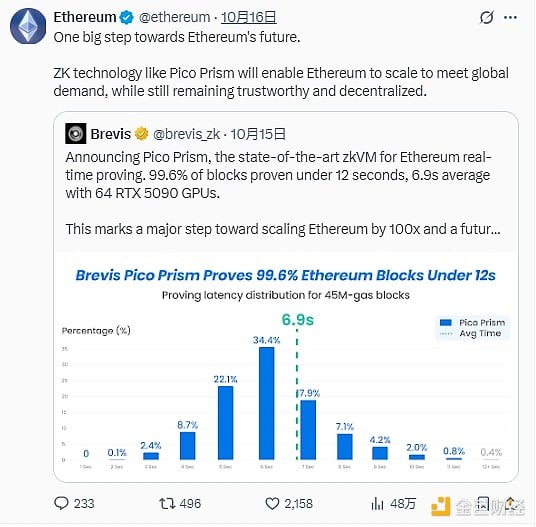
On October 15, Vitalik retweeted and commented: "Glad to see @brevis_zk's Pico Prism entering the ZK-EVM verification space! The ZK-EVM verification speed and diversity have taken an important step forward."
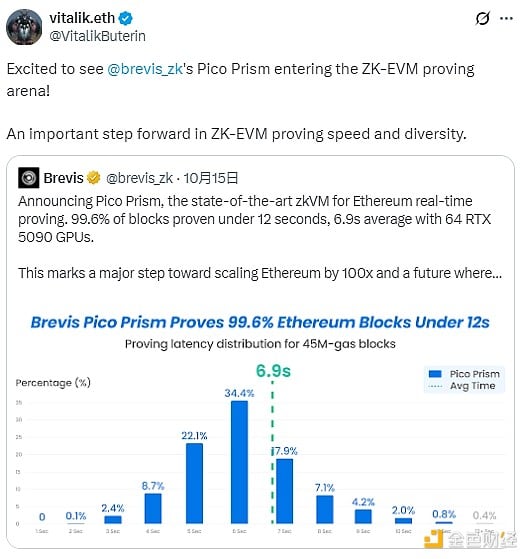
Ethereum core developer Justin Drake also joined in the shout-out.

What is Pico Prism that has the Ethereum official account so excited?
1. Technical Breakthrough of Pico Prism
Pico Prism, developed by Brevis, achieves real-time proof (RTP) for Ethereum Layer-1 using consumer-grade hardware equipped with 64 RTX 5090 GPUs. In tests conducted in September, Pico Prism achieved 99.6% real-time proof in under 12 seconds.
Brevis's blog post introduces Pico Prism as follows:
Pico Prism is the first to achieve real-time proof for 45M gas limit blocks using affordable consumer-grade hardware. We benchmarked Pico Prism on 8 servers, each equipped with 8 RTX 5090 GPUs, totaling 64 GPUs. To compare with SP1 Hypercube, we uniformly sampled 1,000 blocks from the same time period of the Succinct benchmark. For the 45M gas limit blocks, we benchmarked each block generated on September 1, 2025.
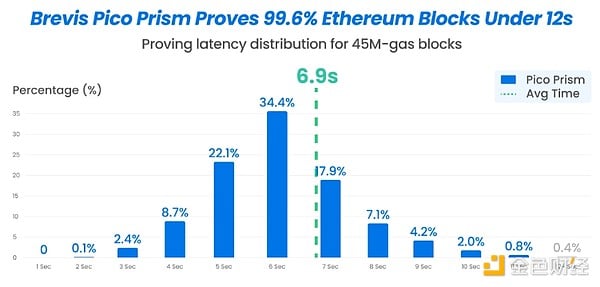
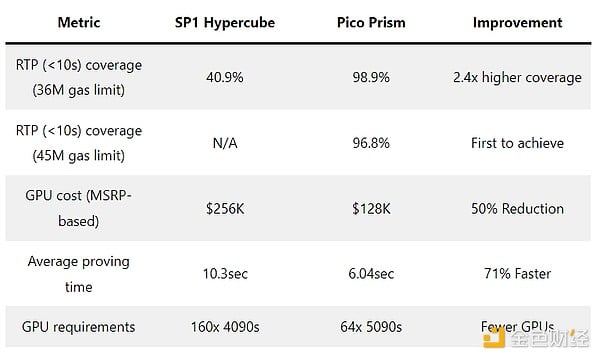
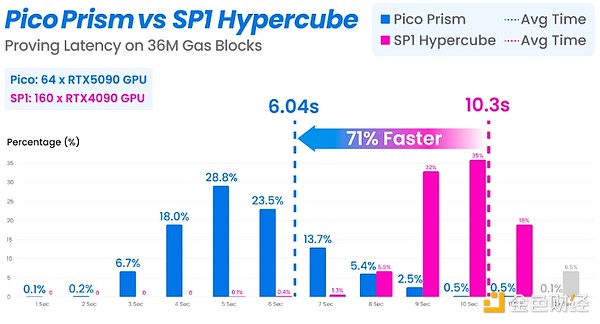
In addition to individual metrics, Pico Prism achieved a 3.4 times performance advantage in speed and cost efficiency (calculated as average verification time × hardware cost) compared to SP1.
Pico Prism uses consumer-grade RTX 5090 GPUs, proving that real-time verification can be achieved without expensive data center hardware.
Multi-GPU and Multi-Machine Proofs
The transition from a single-machine single-GPU prover to a fully distributed multi-machine multi-GPU architecture is a significant breakthrough for Pico. The core of this leap is a complete redesign of the computational pipeline.
Thanks to Pico's modular design, the proof process is broken down into multiple stages, from simulation to hierarchical recursion. Compute-intensive workloads are offloaded to the GPUs, while setup tasks remain on the CPU, executed in a highly parallel pipeline, thus maintaining GPU saturation and operating at maximum efficiency. This extreme optimization and parallelization provide nearly linear acceleration when scaling across multiple machines and GPUs, resulting in a transformative and undeniable outcome: Pico Prism achieves true real-time proof at Ethereum scale using easily accessible consumer-grade hardware.
Future Plans
With the release of Pico Prism, the path for Ethereum L1 zkVM integration has become clearer. While we are only 2.2% away from the updated goal of real-time verification within 10 seconds, we have begun rolling out some readily available new features to easily achieve this goal.
The next important milestone for Pico Prism focuses on reducing verification costs. We have laid out a roadmap aimed at achieving 99% real-time verification using fewer than 16 RTX 5090 GPUs in the coming months.
2. Significance for Ethereum
1. Achieving Lightweight Verification
This breakthrough means that the computationally expensive proofs can finally keep pace with block production speed using affordable consumer hardware, making lightweight verification feasible for the first time. Currently, each verifier re-executes every transaction to validate blocks, which requires expensive hardware and creates fundamental bottlenecks. But "real-time proof breaks this pattern. One prover generates a proof, and others verify it within milliseconds."
2. Moving Towards 10,000 TPS
According to Ethereum's roadmap, verifiers will transition from re-executing transactions to simply verifying ZK proofs, allowing the base layer to reach 10,000 transactions per second.
Ryan Sean Adams from Bankless points out: "If we scale at three times a year, by April 2029, Ethereum L1's TPS will reach 10,000 TPS."
Bitcoin security researcher Justin Drake explains: The Ethereum Fusaka upgrade is expected to occur in December, simplifying real-time proof. "EIP-7825 limits the gas usage per transaction, allowing for more parallel proofs through sub-blocks. By the end of this year, several teams will prove each L1 EVM block on 16-GPU clusters, with a total power consumption of less than 10kW."
3. Running Nodes on Mobile Phones
Tech entrepreneur Mike Warner states: "The future of mobile phones as nodes is about to become a reality."
Adams notes that Ethereum is transitioning to a zk chain: Layer 1 will run global DeFi with a TPS of 10,000 for its large blocks, and nodes will be able to run on mobile phones, while Layer 2 will handle everything else. "No other blockchain follows this strategy—using zero-knowledge proof technology to achieve maximum scalability and decentralization. Bitcoin remains conservative in first-generation cryptography. Ethereum is actively transitioning to second-generation cryptography. Other blockchains use nodes that require data centers for scaling."
This is essentially the holy grail of blockchain: achieving massive scalability without sacrificing decentralization or security.
3. What is Real-Time Proving, and Why is it Important for Ethereum?
Real-time proving is a new, more efficient technology that allows for transaction verification by generating a small proof instead of requiring each node to re-execute all transactions, significantly increasing transaction speed and reducing costs. For Ethereum, it is important because it enables large-scale expansion without sacrificing decentralization, making Ethereum transactions faster, cheaper, and more secure.
- Significant Scalability: Real-time proving greatly enhances Ethereum's transaction processing capacity without compromising decentralization.
- Cost Reduction: Since nodes do not need to perform complex computations, the cost of transactions will be significantly lowered.
- Increased Speed: Transaction verification speed is greatly improved, leading to a better user experience.
- Enhanced Security: By making transaction verification more efficient and secure, real-time proving helps to strengthen the overall security of the Ethereum network.
Mo Dong, CEO and co-founder of Brevis, states: "The data speaks for itself. The infrastructure we built can handle the actual production data of Ethereum today. Faster performance brings economic benefits, making real-time proving feasible for production deployment."
With Pico Prism, the path for Ethereum L1 zkEVM integration has now become clearer.
免责声明:本文章仅代表作者个人观点,不代表本平台的立场和观点。本文章仅供信息分享,不构成对任何人的任何投资建议。用户与作者之间的任何争议,与本平台无关。如网页中刊载的文章或图片涉及侵权,请提供相关的权利证明和身份证明发送邮件到support@aicoin.com,本平台相关工作人员将会进行核查。




